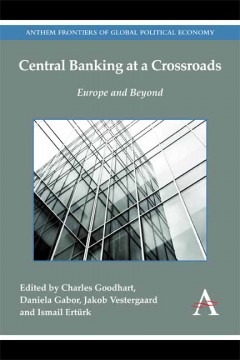Central Banking at a Crossroads
Europe and Beyond
Edited by Charles Goodhart
Daniela Gabor
Jakob Vestergaard
Ismail Ertürk
Anthem Frontiers of Global Political Economy and Development
Other Formats Available:
- About This Book
- Reviews
- Author Information
- Series
- Table of Contents
- Links
- Podcasts
About This Book
Since the 2008 collapse of Lehman Brothers, central banking has changed dramatically. Over the past five years central banks have intervened in both public and private debt markets, taking on functions of dealers of last resort, while simultaneously designing regulatory and resolution frameworks with the explicit aim of changing bank business models, all in order to contain and better address systemic risk. This book explores these developments through collected essays from authors from both academia and policy circles, and sets them in the context of the European crisis.
‘Central Banking at a Crossroads’ reflects on the innovations central banks have made to improve their modes of intervention, regulation and resolution of financial markets and financial institutions in four related sections: ‘Bank Capital Regulation’ examines the Basel III agreement, identifying its key novelties and shortcomings vis-à-vis its predecessor, Basel II; ‘Bank Resolution’ focuses on effective regimes for regulating and resolving ailing banks; ‘Central Banking with Collateral-Based Finance’ develops thought on the challenges that market-based finance pose for the conduct of central banking in periods of economic stability and, through a critical theoretical angle, the important role that governments play for financial markets as manufacturers of high-quality collateral or safe assets; and, finally, ‘Where Next for Central Banking’ examines the trajectory of central banking, its issues, and its new, central role in sustaining capitalism.
Reviews
“Focusing on solvency questions, this book provides a representative sample of the current state of debate, a first and useful step in the urgent project of reconceptualizing the role of central banking for the modern world.” —Perry Mehrling, Barnard College, Columbia University
“Big crises challenge our thinking and even entire paradigms of economics. Many of the authors in this volume are well known for their ideas for further regulatory reforms after the crisis. The book’s thought-provoking and sometimes controversial views are very welcome to the discussion even if one would not necessarily agree with all of them.” —Erkki Liikanen, Governor of the Bank of Finland
“This is the book finance experts have been waiting for. For those who seek concrete case studies and empirics on the transformative role of central banks since the financial crisis, this important volume amply fills this niche. This rigorous and novel investigation is a ‘must-read’ for all who either approve or disapprove of the unconventional instruments and practices used by central banks that have extended the mandate and blurred the traditional line between monetary and fiscal policy.” —Brigitte Young, University of Münster, Germany
“Focusing on solvency questions, this book provides a representative sample of the current state of debate, a first and useful step in the urgent project of reconceptualizing the role of central banking for the modern world.” —Perry Mehrling, Barnard College, Columbia University
“Big crises challenge our thinking and even entire paradigms of economics. Many of the authors in this volume are well known for their ideas for further regulatory reforms after the crisis. The book’s thought-provoking and sometimes controversial views are very welcome to the discussion even if one would not necessarily agree with all of them.” —Erkki Liikanen, Governor of the Bank of Finland
“This is the book finance experts have been waiting for. For those who seek concrete case studies and empirics on the transformative role of central banks since the financial crisis, this important volume amply fills this niche. This rigorous and novel investigation is a ‘must-read’ for all who either approve or disapprove of the unconventional instruments and practices used by central banks that have extended the mandate and blurred the traditional line between monetary and fiscal policy.” —Brigitte Young, University of Münster, Germany
Author Information
Charles Goodhart is director of the Financial Regulation Research Programme at the London School of Economics.
Daniela Gabor is an associate professor at the University of the West of England in Bristol.
Jakob Vestergaard is a senior researcher at the Danish Institute for International Studies in Denmark.
Ismail Ertürk is a senior lecturer at Manchester Business School at the University of Manchester, UK.
Series
Anthem Frontiers of Global Political Economy and Development
Table of Contents
Preface; 1. Introduction; 2. Constraining Discretion in Bank Regulation; 3. Fallacies and Irrelevant Facts in the Discussion of Capital Regulation; 4. Complexity, Interconnectedness: Business Models and the Basel System; 5. At the Brink of Insolvency: Shallow Recapitalization Exercise Fails to Bolster Europe’s Ailing Banks; 6. Bank Resolution in Comparative Perspective: What Lessons for Europe?; 7. Resolving Problem Banks: A Review of the Global Evidence; 8. Bank Resolution in New Zealand and Its Implications for Europe; 9. Collateral and Monetary Policy; 10. The ECB and the Political Economy of Collateral; 11. The Backstory of the Risk-Free Asset: How Government Debt Become “Safe”; 12. Central Banking Post-Crisis: What Compass for Uncharted Waters?; 13. Reconceptualising Central Bank Unconventional Policies: Long Positions on No-Growth Capitalism; 14. The Future Relationship between Central Banks and Governments: What Are Central Banks For?; 15. Is New Governance the Ideal Architecture for Global Financial Regulation?; Contributors; Index
Links
Stay Updated
Information
Latest Tweets



